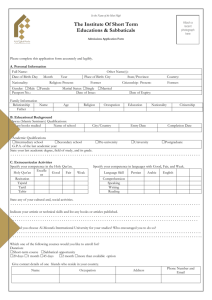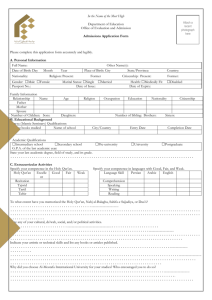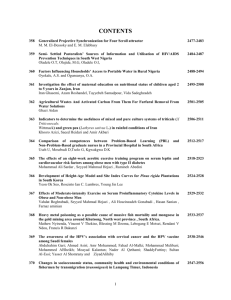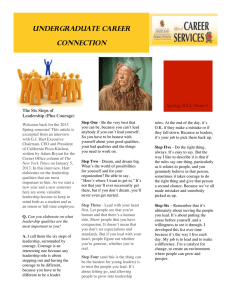Elam & Susa - Anahita Productions
advertisement
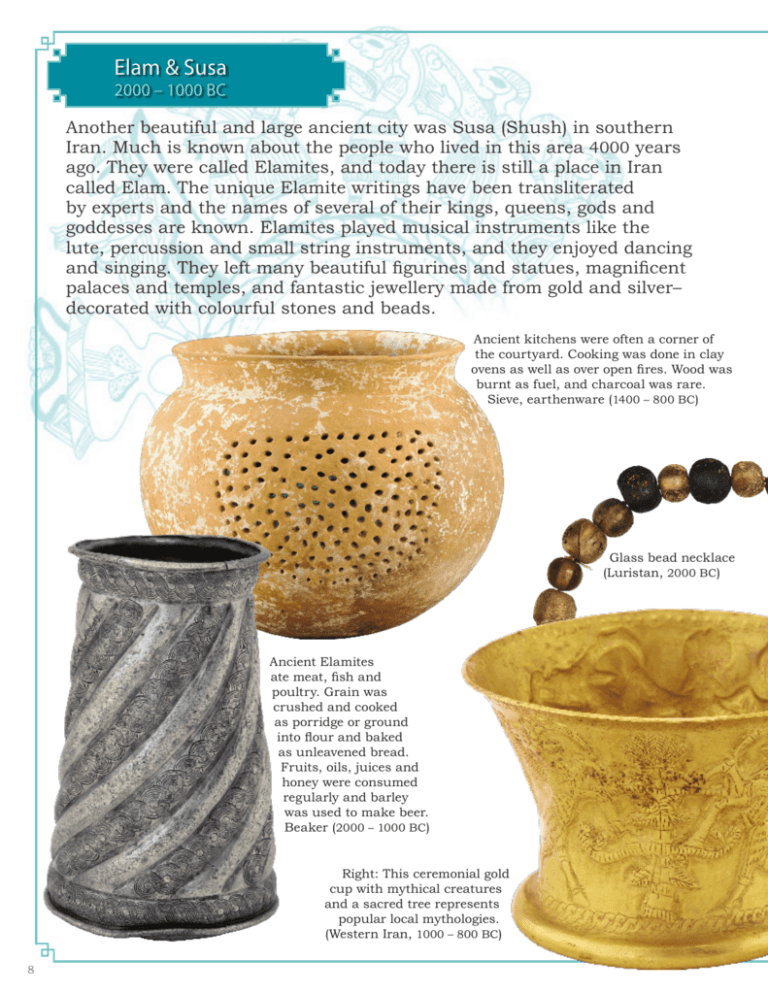
Elam & Susa 2000 – 1000 BC Another beautiful and large ancient city was Susa (Shush) in southern Iran. Much is known about the people who lived in this area 4000 years ago. They were called Elamites, and today there is still a place in Iran called Elam. The unique Elamite writings have been transliterated by experts and the names of several of their kings, queens, gods and goddesses are known. Elamites played musical instruments like the lute, percussion and small string instruments, and they enjoyed dancing and singing. They left many beautiful figurines and statues, magnificent palaces and temples, and fantastic jewellery made from gold and silver– decorated with colourful stones and beads. Ancient kitchens were often a corner of the courtyard. Cooking was done in clay ovens as well as over open fires. Wood was burnt as fuel, and charcoal was rare. Sieve, earthenware (1400 – 800 BC) Glass bead necklace (Luristan, 2000 BC) Ancient Elamites ate meat, fish and poultry. Grain was crushed and cooked as porridge or ground into flour and baked as unleavened bread. Fruits, oils, juices and honey were consumed regularly and barley was used to make beer. Beaker (2000 – 1000 BC) Right: This ceremonial gold cup with mythical creatures and a sacred tree represents popular local mythologies. (Western Iran, 1000 – 800 BC) 8 By 7000 BC, small-scale agriculture was widespread in both Iran and the neighbouring areas. The earliest crops were flax, wheat, barley, peas, lentils and chickpeas. Flax was used in the production of nets, cloth, linseed oil and medicine: all had commercial value. (1st millenium BC) Knob made of gold, copper alloy and iron (Northwest Iran, 1000 BC) Animal sculpture discovered in Qazvin. (1000 BC) Right: High-ranking women in ancient Elam enjoyed wealth and prestige. This life-size bronze and copper statue shows Queen Napir Asu. She wears an elaborately embroidered dress. The statue has an inscription in Elamite, cursing any one attempting to destroy the sculpture. (Susa, 13th century BC) Strainer, red clay (1350 – 1000 BC) 9 Axe head (1350 – 1000 BC) Bronze was made from mixing tin and copper and involved mining and advanced smelting techniques. The manufacturing of bronze also engendered trade and import/export activity, since copper and tin mines normally do not occur in the same area. Spearhead (2000 – 1000 BC) Beaker with ibex (Susa, 4000 BC) Spouted jar (2000 – 1000 BC) Funnel-shaped silver object (2000 – 1000 BC) 10 Bronze dagger (3000 – 2000 BC) Musicians and entertainers were an integral part of palace, temple and daily life. Almost all categories of instruments existed in Elam, from clappers and scrapers to rattles, flutes, clarinets, oboes, trumpets, harps, lyres and lutes, etc. (Elam, 2000 BC) Shallow bronze bowl with Elamite inscription (Arjan, Iran) Earthenware bottle (2000 – 1000 BC) The Elamites used linen, flax, cotton and leather to make clothing. Most households spun their own wool and wove their own textiles. (Elam, 700 – 600 BC) 11 Chogha Zanbil Temple Chogha Zanbil Ziggurat was built by King Untash-Napirisa (1275 – 1240 BC). This gigantic temple complex covers an area of over 11,000 m², with its highest tower reaching a height of 52 m. The inner walls had paved terraces on each floor, and the building contained an elaborate water treatment system. The outer wall had several gates; the inscription inside one indicates that the temple was built for the Elamite goddess, Lady of Lyan. It also housed a sanctuary for the deity Insusinak, the protector of Susa. Temple scene from Elam showing males praying next to a Ziggurat. Males and females from all classes served and worked at the temples. Some were of high rank and exerted great influence. In Iran, the technology to make glass dates back at least 5000 years. These glass sticks were used for decorating walls and panels. Chogha Zanbil Ziggurat (Susa, 2000 – 1000 BC) 12 Ceremonial bronze belt (2000 – 1000 BC) Chogha Zanbil Ziggurat The ancient Elamites worshipped several male and female deities and celebrated many joyful feasts with music, food and wine. Male worshipper making an animal offering to a deity or a temple. (Susa, 2000 BC) Above: Goddesses and priestesses played a major role in Elamite cosmology. Many women including queens and princesses participated in temple functions. These images of an Elamite goddess dressed in sheepskin are from a ceremonial cup that was discovered in Iran. (2100 BC) Male dignitary wearing a hat commonly associated with divinity. The pantheon of the Elamite gods was headed by the goddess Pinikir, the Mistress of Heaven. (Susa, 2000 BC) 13 The Medes 612 – 550 BC Around 1700 BC, various nomadic tribes migrated to Iran over a period of 1000 years. These groups gradually occupied many areas in western Iran, and lived alongside other non-Iranians. The most famous of the Iranian tribes were the Medes and the Persians. The Medes formed the first major Iranian kingdom and managed to defeat the Assyrian kings of Mesopotamia in modern Iraq. Assyrian kings were powerful rulers and had forced thousands of Jews to come and live in Iran near Hamadan (ancient Ecbatana). The Jewish colony of Hamadan exists today and dates back nearly 2800 years. There is also an Assyrian Christian group in Iran that trace back their origins to ancient times. In 612 BC the Medes defeated the Assyrians and conquered the legendary city of Nineveh. They united the Iranian tribes and started building up a new army with 3 main divisions: spearmen, bowmen and cavalry. (Medes, Persepolis) Gold cup (Caspian region, 800 – 700 BC) 14 This decorative breastplate made of a thin sheet of gold would have been attached to leather and may have been fashioned specifically for ceremonial use or burial equipment. A breastplate shielded the chest from arrows or other weapons. The decoration on this example consists of mythical creatures, whose images were believed to provide magical protection for the wearer. (800 – 500 BC) Gold cup (Caspian region, 800 – 700 BC) Above: Gold bracelet attached to two rings with skillfully crafted chains. (Ziwiye, 1000 – 700 BC) Objects from Ziwiye in northwestern Iran are stylistically similar to the art of Assyria, Syria, Urartu (Armenia) and Scythia. Hollowed gold bracelet with animal heads (Ziwiye, 700 BC) The Medes entered northeastern Iran around the 17th century BC and appear in Assyrian texts from around the 9th century BC. The position of this man’s hand indicates that he might be a priest (mogh). 15 Style & Religion The Medes lived mostly in Hamadan and Azerbaijan, but gradually spread all over the region. They were known for their clothing and religion. Many wore tight trousers with tunics and long coats. They made trousers very fashionable and popular at a time when most men wore skirts. The priests, known as magi, sang important songs and performed prayers and other religious ceremonies for the royalty. According to the Bible, the Three Wise Men (Magi from Persia) traveled to the birthplace of Jesus to greet him guided by a comet. The Medes ruled for a short period before their close relatives, the Persians, replaced them in the 6th century BC. Ancient Greek sources have made a number of references to the Median dress, particularly, the “Median Robe” worn by the Persian kings during ceremonies. Typical Median clothing included trousers and a tunic with a belt and hat. A long ceremonial coat with long false sleeves was worn on top. A similar coat is still worn today in Afghanistan. Pressed gold plaques showing mythical characters were sewn onto clothing or belts. (Ziwiye, 7th century BC) 16 Right: Medes and Persians are often portrayed together in carvings at Persepolis. The Medes are mostly shown wearing rounded felt hats, different from those of the Persians. (Photo Joachim Waibel) Left: Pins had multiple uses. They were worn in hair or with clothing and also had ceremonial and symbolic functions. (Luristan, 7th – 8th century BC) Left: Median priest holding ceremonial branches. Gold plaque (Oxus treasure) Above: Elaborate belts were a significant symbol of authority in Iran for many centuries. Leather belts were decorated with decorative golden objects. (1000 – 700 BC) 17




